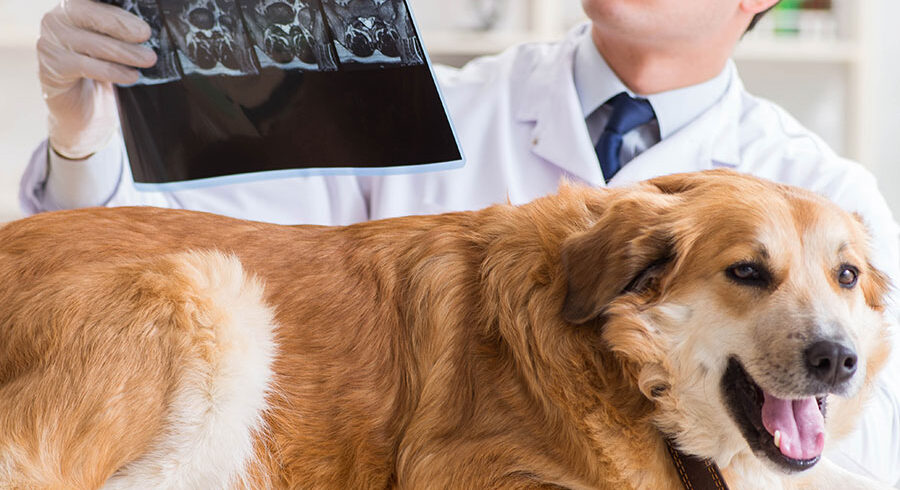
Imaging is used when your pet’s medical care staff needs to learn more about the animal’s condition. These technologies are designed to take pictures of the structures and processes inside your pet’s body so that the best course of care can be recommended. The precise type of images taken will depend on the symptoms your pet is displaying as well as the parts of their body that are involved. With our full compliment of expert staff and state-of-the-art equipment, Animal Emergency and Urgent Care Center (AEUCC) should be your premier choice for veterinary diagnostic imaging in Boca Raton, Coral Springs, Deerfield Beach, Margate, Parkland, Fort Lauderdale Pompano and the surrounding areas. In order to provide your furry companion with the best possible diagnostic care, our Florida emergency pet hosptial furnishes pet owners and their regular veterinary practices with a variety of emergency pet diagnostic imaging services.
Also known as x-ray studies, this common type of digital imaging involves taking pictures of a specified area in the body, generally the chest, abdomen or musculoskeletal system, through use of short bursts of x-rays. In addition, this technology is often employed to diagnose obstructions in the gastrointestinal and urinary tracts through the use of contrast.
When you bring your critically ill animal into our South Florida emergency pet hosptial, radiography is often the first diagnostic step we take in understanding the seriousness of conditions including the following:
In order to provide superior radiographic diagnosis and monitoring, AEUCC uses the latest technology featuring over 300 preset parameters to accommodate animals of different sizes as well as various locations in the body. The clear digital images that result are sent within seconds to our expert team of board-certified radiologists who analyze the data and return their reports within minutes.
Ultrasonography is the second most frequently used imaging mechanism in today’s veterinary practices. It involves the use of ultrasonic sound waves in the frequency range of 1.5–15 megahertz (MHz) to create images of body structures based on the pattern of echoes reflected from the tissues and organs being studied. The most commonly used ultrasound method is b-mode, also known as brightness mode or 2D ultrasound. It uses reflected images to create exceptionally clear pictures of the animal’s internal organs and structures. Veterinarians rely on this versatile and easy to use imaging technology to assess organ size, find fluid accumulation, identify tumors or masses and evaluate organ function.
Ultrasonography involves applying a transmission gel to the animal’s body and then moving a transducer across the area. The transducer first emits a short burst of sound which travels into the pet’s body. The transducer then switches to “receive” mode and registers the echoes that occur when sound bounces from tissues of varying densities. Some of these echoes are then converted into impulses and recorded by the ultrasound machine, resulting in the creation of an image that can be analyzed. As the transducer is moved across the body, the system creates a series of these dynamic images that change in real time, allowing the technician to continue scanning until a comprehensive picture is achieved. This image can then be frozen and recorded for further study.
In spite of its usefulness, ultrasonography has limitations. It cannot be used to analyze gas-filled or bony tissue. In addition, its accuracy is reduced at depths of more than 24 cm. Even so, it remains a top choice for imaging of the heart and abdominal organs as well as muscles, tendons and ligaments. Today’s technology even allows for the scanning of the pancreas, adrenal glands and lymph nodes.
This imaging technology involves using ultrasound to assess the animal’s cardiac functioning. A beam of sound is projected into the heart to evaluate the pattern and amplitude of movement in the various cardiac chambers. It is also possible to examine the size and appearance of the structures detected by the beam. Today’s brightness mode equipment is being used to augment the more traditional echocardiography technology to learn additional details about chamber shape and quantitative data such as cardiac output, ejection fraction, ventricular contractility and ventricular wall stiffness.
This type of ultrasound uses high-pitched sound waves to measure blood flow through veins, arteries and vessels but does not directly look at any bodily structures. It is commonly employed to detect blood clots and blockages, point out veins or valves that are not functioning properly and pinpoint decreased blood circulation throughout the body.
The results can be displayed on a smaller scale to examine the functioning of a particular vessel. Alternatively, images can encompass a larger scan, using the color spectrum to depict blood flow direction and mean velocity. Thanks to Doppler studies, the accuracy and specificity of electrocardiograms is enhanced. Moreover, Doppler can be very effective in assessing the blood flow in the abdomen and other areas and in diagnosing arterial or venous thrombosis or malformation.
At AEUCC, our facility offers state-of-the-art imaging services with the help of our Fuji Sonosite Edge Ultrasound system. Our experienced staff is trained in both abdominal/thoracic ultrasound and echocardiography, and we are available day and night 365 days a year to provide fast, accurate monitoring and diagnosis. We are committed to offering the people and veterinary practices of South Florida with the highest standard of care and consultation for all types of critical care needs, including trauma, poisonings, animal attacks, severe illnesses, seizures and more. Should you or your pet ever experience an emergency, contact our friendly, compassionate staff right away. We are located at 103 N. Powerline Rd. Deerfield Beach, Fl 33442 – and we welcome your call at (954)428-9888 day or night.
